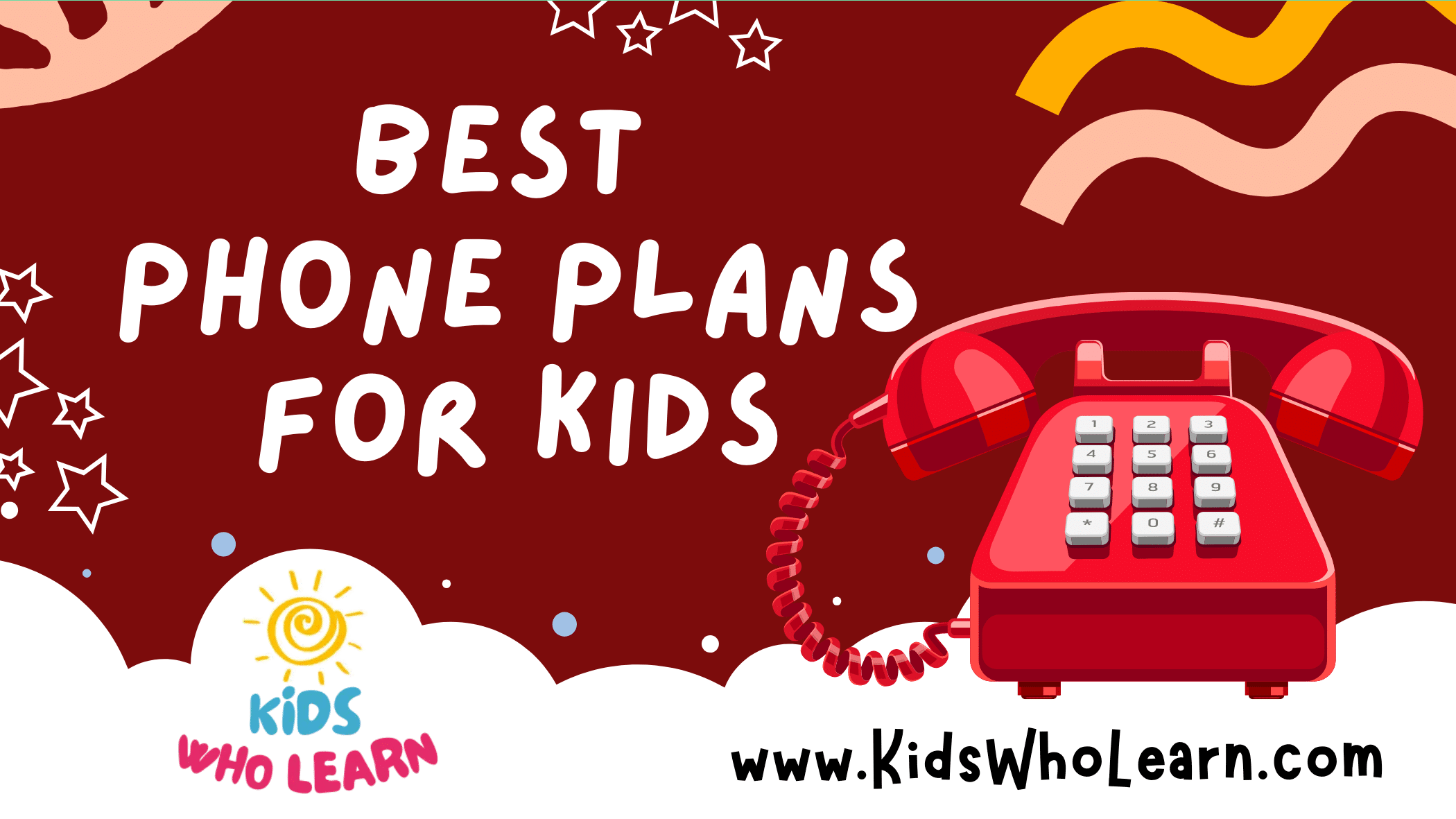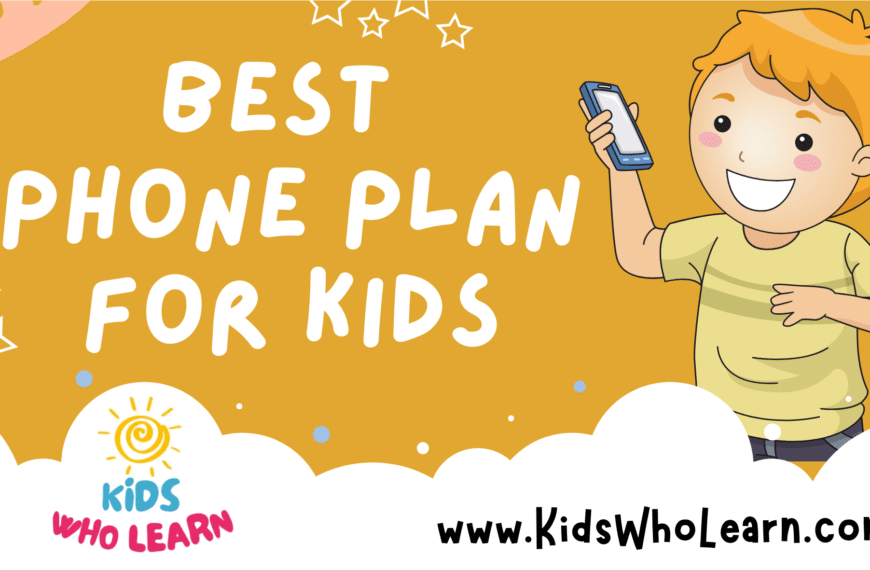Selecting the right phone plan for a child is a decision that merges financial sensibility with the need for communication and safety. It’s not just about finding the lowest prices—parents must also consider the features and limitations that suit their child’s age and maturity level. The appropriate plan balances sufficient talk and text capabilities with access to data and internet, while also providing tools for monitoring and controlling usage to ensure a safe and moderated introduction to mobile technology.
For optimal value, parents should evaluate the diversity of plans offered by various carriers, each with its perks and drawbacks. Some carriers might provide plans specifically designed for children with built-in parental controls, while others may feature flexible family plans that can grow with the child’s needs. Cost, network coverage, and customer support are also important factors. A plan that offers the advantage of low prices but lacks extensive coverage or after-purchase support can turn out to be less beneficial in the long run.
The search for a suitable phone plan for kids requires attention to detail and an understanding of the child’s specific needs. A comprehensive review of plan features, network quality, and ancillary services helps prevent unexpected costs and ensures that the selected plan aligns with the child’s usage while empowering parents with the necessary oversight tools.
Key Takeaways
- Essential factors include cost, parental controls, and coverage quality.
- Flexibility and growth potential are key in selecting a long-term plan.
- Review and comparison of plans ensure a suitable match for a child’s needs.
Understanding Phone Plans for Kids
When selecting phone plans for kids, it’s essential to balance the need for communication with cost-effectiveness and appropriate oversight.
Key Considerations
Identifying the right cell phone plan for your child involves several factors. First, determine data needs—while some kids might require unlimited data for educational apps and browsing, others may use the phone primarily for essential communication, making a limited data plan more suitable. Consider the volume of talk and text as younger children may rely more on calls. Furthermore, a family plan can offer convenience and often comes with discounts for multiple lines.
Next, assess which carriers support the coverage you need, recognizing that not all networks are equal, and some areas have better reception with specific carriers. Explore plans from both traditional carriers and MVNOs (Mobile Virtual Network Operators), which can offer competitive rates on the same networks.
Lastly, evaluate the need for parental controls or monitoring services and ensure any chosen smartphone can support these tools.
Types of Plans Available
Prepaid Plans offer a fixed amount of talk, text, and data for a set fee and are advantageous for controlling costs and usage. These are ideal for parents who wish to avoid overage charges.
Postpaid Plans usually involve a contract or monthly billing, but they often come with the benefit of being part of a family plan, where discounts and shared data packages could be economical for households with multiple users.
Unlimited Plans may seem excessive, but for teenagers or kids who frequently stream videos or use data-intensive apps, these plans prevent surprise costs from data overages. It’s important to read the fine print; some unlimited plans may throttle data speed after reaching a specific limit.
Choosing the right phone plan for your child requires careful consideration of their needs and your budget. By reviewing each type’s advantages, you can effectively determine the plan that best matches your child’s usage and your family’s financial plan without compromising on the essential aspects of communication and safety.
Best Phone Plans for Kids by Carrier
Choosing the right phone plan for your child involves finding a balance between cost, data, and parental controls. Here, you’ll find tailored options from major carriers and MVNOs (Mobile Virtual Network Operators) that offer appealing features for kids’ use.
Verizon’s Offerings
Verizon provides a Just Kids plan when added to your Unlimited plan. It includes 5GB of 4G LTE data, unlimited talk and text to 20 contacts, and Verizon Smart Family Premium for parental controls. Pricing varies based on your existing plan:
- 2+ lines: $35/line
- 3+ lines: $30/line
- 4+ lines: $25/line
T-Mobile’s Options
T-Mobile’s kid-friendly plans can be tied to their family plans. You can add your child’s line with features like unlimited talk, text, and a data allotment of your choice, which ranges from 2GB to unlimited data. Their plans also come with Family Allowances, providing control over your child’s calling and texting.
- Magenta Plan: Unlimited data and includes taxes and fees.
- Magenta Plus: Extra benefits like HD streaming and more high-speed data abroad.
AT&T Selection
With AT&T, flexibility is a highlight. Choose from plans like the AT&T Prepaid for control over spending or join a family plan with unlimited talk, text, and tiered data options:
- AT&T Prepaid: Starts at $30/month for 5GB of data.
- Unlimited Starter: Affordable unlimited plan with parental controls as an add-on.
MVNO Alternatives
MVNOs such as Tello, Mint Mobile, US Mobile, Visible Wireless, Metro by T-Mobile, Boost Mobile, Consumer Cellular, and Google Fi offer tailored plans often at lower prices. They operate on the networks of major carriers, ensuring reliable coverage.
- Tello: Plans start at $5/month with customizable talk, text, and data.
- Mint Mobile: Bulk savings on plans, starting at $15/month for 3GB.
- US Mobile: Custom plans with pooled data options and parental controls.
- Visible Wireless: One simple plan with unlimited data on Verizon’s network at $40/month.
- Metro by T-Mobile: Special deals on family plans with added perks.
- Boost Mobile: Competitive prepaid plans with growing network coverage.
- Consumer Cellular: Special rates for AARP members and adjustable plans.
- Google Fi: Plan flexibility and international features ideal for families on the go.
Online Safety and Parental Controls
When selecting phone plans for your kids, paying attention to online safety and parental controls is essential to ensure they have a secure and age-appropriate mobile experience. Use network-level controls and third-party parental control apps to customize their digital environment.
Network-Level Controls
Your child’s safety on their phone starts with network-level controls, which are services provided by the carrier to manage your child’s phone usage. For example, Verizon’s Smart Family service allows you to:
- Filter content: Block access to inappropriate websites and data.
- Set time restrictions: Limit phone usage during specific hours, such as school time or bedtime.
- Monitor usage: Keep an eye on call and text activity.
Third-Party Parental Control Apps
In addition to network-level controls, consider third-party parental control apps that offer advanced features to protect your kids and teens. Popular apps like Qustodio and Norton Family provide functionalities such as:
- Location tracking: Stay informed about your child’s whereabouts.
- Screen time management: Set limits on how much time your child spends on their phone.
- App management: Control app downloads and usage, ensuring kids use only appropriate apps.
With these tools at your disposal, you can manage and monitor your child’s phone activity effectively, creating a safer digital space for them to explore.
Cost-Effective Strategies
When selecting a phone plan for your kids, focusing on cost-effectiveness can yield significant savings. Explore discounts and perks that cater to your budget, and consider the advantages of family plans to maximize value.
Discounts and Perks
To reduce costs, look for discounts available specifically for children’s phone plans. Providers often offer promotions for new customers that may include lower monthly rates or waived activation fees. It’s also worth checking if your employer has partnerships with phone carriers, which can result in exclusive employee discounts.
- Back-to-School Offers: Typically available towards the beginning of the school year, these can include either a price reduction or bonus features at no extra cost.
- Student Discounts: Some carriers provide discounts for students, which could apply if you are purchasing a plan for a teen.
Family Plan Benefits
Family plans are structured to be more affordable when multiple lines are added. These plans often come with a set base price that includes a certain number of lines, with the option to add more at a reduced rate.
| Number of Lines | Monthly Rate (Base) | Cost per Additional Line |
|---|---|---|
| 2 | $60 | +$20 |
| 4 | $100 | +$15 |
- Shared Data Pools: Most family plans feature shared data allocations, which can be more cost-effective than individual data plans, especially if usage varies among family members.
- Parental Controls: These are frequently included in family plans at no additional cost which allows you to monitor and control your kid’s phone usage.
By taking advantage of these strategies, you can find a phone plan for your kids that not only meets their needs but also aligns with your financial considerations.
Plan Features and Extras
When selecting a phone plan for kids, it’s essential to consider not just costs but also the specific features that match their needs, such as data allowances and added services.
Data Plans and Usage
Your child’s phone plan may offer different tiers of data usage. A flexible data plan allows you to pay for only the data your child uses, which can be cost-effective for lighter users. Unlimited data plans, on the other hand, are ideal if your child uses a significant amount of data for browsing, streaming, and gaming. Providers may separate these into:
- Unlimited talk and text plans: Usually the base of any phone plan, providing the fundamental services without data.
- Unlimited data plans: Provide a worry-free experience with no overage fees, but they may have limitations such as reduced speeds during high-traffic times.
- High-speed data options: These plans offer a certain amount of data at 4G LTE or 5G speeds, after which speeds get throttled.
- Premium data plans: These often include both high-speed and hotspot data, and prioritize your data usage even during congested periods.
Additional Services
Your child’s phone plan can be supplemented with a variety of extra services that enhance the user experience:
- Hotspot Data: Lets your child turn their device into a Wi-Fi hotspot, but keep in mind that only some plans offer this feature without additional cost.
- Cloud Storage: Useful for backing up photos, videos, and documents. Some plans may include a set amount of free cloud storage.
- International data: If your family travels, look for plans that offer international data without excessive roaming charges.
- Party Pay or Family Plans: These allow savings through group discounts when multiple lines are on one account.
- Mix and Match: Some carriers provide the flexibility to combine different types of plans within one family plan, adapting to the individual needs of each family member.
Practical Tips for Parents
Selecting the right phone and plan for your child can be a straightforward process. Keep a keen focus on device suitability and cost-effective plan options, prioritizing essential features.
Phone Selection Advice
When choosing the best phone for your child, consider durability and functionality. Devices like the iPhone SE or the Moto E are excellent starting points due to their solid build and user-friendly interfaces. Here’s a table of phone features to consider:
| Feature | Description |
|---|---|
| Durability | Opt for phones with strong build quality or invest in robust cases. |
| Ease of Use | Simple interfaces help kids navigate their phones better. |
| Parental Controls | Ensure the device supports apps or built-in features for parental oversight. |
For cost savings, consider bring your own phone (BYOP) plans if you have a spare device that is still functional. This approach often eliminates the cost associated with purchasing a new device.
Monitoring Usage and Costs
Keeping track of your child’s phone usage and the associated costs ensures safety and avoids unexpected bills. Look for cell phone plans for kids that offer no contract terms, making it easier to change or cancel plans as needed.
Here are key points in monitoring:
- Data Usage: Opt for plans with fixed data limits or alerts to monitor usage.
- Tracking: Incorporate GPS features to help locate your child when necessary.
- Cost Control: Choose prepaid plans to cap expenses and teach your child budgeting.
Below is a simple checklist for monitoring components:
- Check for real-time usage stats via the carrier’s app.
- Set up usage alerts or limits.
- Use tracking apps compatible with your child’s phone plan.
By focusing on these principles, you can ensure your child has a phone and plan that fit their needs while maintaining peace of mind about safety and costs.
Coverage and Network Quality
When selecting a phone plan for kids, coverage and network quality are crucial. These factors determine the reliability and speed of the service they will experience.
Understanding Network Coverage
Network coverage refers to the geographical area where a carrier’s signal is available. Nationwide networks typically offer comprehensive coverage, meaning your child’s phone can have signal in most parts of the country, including both urban and rural areas. Here are key aspects to consider:
- 4G LTE Network: This is the most widespread network type, providing fast data speeds. Ensure the provider offers a robust 4G LTE coverage.
- GSM Network: Global System for Mobile communications (GSM) is a standard for networks and is widely used by carriers, thus compatibility with GSM is a plus.
Comparing Network Performance
While coverage gives you the geographical reach, network performance ensures the quality of the service within that reach. Consider the below points:
- Best Network: Look for unbiased, recent consumer reports and network performance studies to identify providers with the top-performing networks.
- 4G LTE Data Speeds: A plan’s data speed is crucial as it affects the overall user experience. Verify that your chosen provider offers consistent and high-speed 4G LTE data.
By focusing on providers with extensive 4G LTE coverage and high-performance ratings, you can ensure your child stays connected with a reliable phone service.
Special Considerations
When selecting a mobile plan for your child, you must weigh their age-appropriate needs against costs, data allowances, and safety features.
Plans for Younger Children
For younger kids, you’re likely looking for a plan that offers basic connectivity with a keen eye on safety and cost-control. Consider a plan like Verizon’s “Just Kids,” which pairs with a parent’s plan and includes safety features like content filters and location tracking. Data plans for younger children typically offer data deprioritization, meaning after a certain amount of data usage, speeds are reduced.
- Data Cap: Look for plans with a low data cap to keep costs down, as younger children seldom need significant data.
- Safety Features: Prioritize plans that offer comprehensive parental controls to manage what your child can access.
- Cost: Find plans that are specifically tailored for children for potential savings.
Plans for Teenagers
Teens require more data and freedom but still need oversight. A plan for a teen might offer more data before deprioritization kicks in, providing ample streaming and social media access.
- Data Allowance: Opt for higher data limits or unlimited plans that accommodate teenagers’ increased online activity.
- Autonomy vs. Oversight: Balance is key; teens should have the freedom to use their phones while parents maintain some level of control.
- Cost-Effectiveness: Unlimited plans may seem expensive, but they can be economical compared to overage charges on limited plans.
Remember, the right plan will grow with your child’s needs and offer the right blend of connectivity, cost, and control.
Choosing the Right Plan
When selecting a phone plan for your child, prioritize plans that offer flexibility, cost-effectiveness, and appropriate controls for safety and monitoring.
Evaluating Your Needs
Before you compare different phone plans, assess your child’s usage needs. Consider the amount of data they are likely to consume, the essential features like geo-tracking for safety, and the types of controls you want, such as limits on screen time or app usage. Determine if your child requires unlimited texting or just a basic amount of talk time. Consider creating a list or table to itemize these priorities:
| Needs | Your Preferences |
|---|---|
| Data Usage | _ GB per month |
| Talk Time | _ minutes per month |
| Texting | Unlimited / Limited |
| Parental Controls | Yes / No / Specific Apps |
Comparing Your Options
With your list of needs in hand, compare the phone plans offered by various providers, including major carriers and MVNOs (Mobile Virtual Network Operators). MVNOs often have lower-cost plans which might be more suitable for a child’s phone, but coverage can vary. Look for wireless plans that offer a mix and match approach, allowing you to tailor the plan features to match your specific needs without paying for unnecessary extras.
| Feature | MVNOs Plan Example | Major Carriers Plan Example |
|---|---|---|
| Monthly Cost | $20 | $35 |
| Data | 3 GB | 5 GB |
| Talk & Text | Unlimited | Unlimited |
| Parental Controls | Yes | Yes |
By weighing the specific requirements of your child’s phone usage against the variety of plans on the market, you will be well-equipped to choose the most fitting and economical option.
Additional Resources
When selecting the best cell phone plan for your child, you’ll want resources that are current and comprehensive. Here are some valuable tools to aid in your research:
- Comparison Websites: Websites like Wirefly and WhistleOut allow you to compare multiple plans side by side. They can help you sort options based on specific needs, such as data limits and coverage areas.
- Carrier Websites: Visit carrier websites such as Verizon, AT&T, and T-Mobile to get detailed information about their family and kids’ plans. Look for special features like location tracking and content filters.
| Carrier | Plan Features | Coverage Check |
|---|---|---|
| Verizon | Just Kids Plan | Verizon Coverage Map |
| AT&T | AT&T Secure Family Plan | AT&T Coverage Map |
| T-Mobile | T-Mobile Kids Connect Plan | T-Mobile Coverage Map |
- Parental Control Apps: Consider apps like Qustodio, Norton Family Premier, or Circle with Disney to manage and monitor your child’s phone usage.
- Online Forums: Engage with other parents on forums such as Reddit’s r/Parenting or the HowardForums to learn from shared experiences and get advice on the best plans.
- Consumer Guides: The Consumer Reports website offers analyses on various cell phone plans and carriers, helping to make an informed decision based on independent research.
Remember to check for updates frequently, as carriers often change their plans and offers. Use these resources to ensure that you find a plan that balances cost, coverage, and appropriateness for your child’s age and needs.
After Purchase Support
When selecting the best phone plan for your child, consider how customer service can enhance the experience, and note that straightforward, cost-effective assistance is crucial for addressing any issues.
Customer Service Insights
Your chosen phone plan should offer excellent customer service. Ensure the provider has a reputation for responsive and helpful support. Look at the following aspects:
- Accessibility: Customer service should be available through multiple channels such as phone, email, and live chat.
- Operating Hours: Seek out providers with 24/7 customer service in case of urgent needs outside normal business hours.
- Monthly Price Consideration: Some plans with lower monthly prices could mean less comprehensive customer service. Compare to ensure you’re getting the best value.
Troubleshooting Common Issues
Being able to solve common problems quickly is essential. Here’s what to check:
- Online Resources: Look for a provider that offers a robust FAQ and online troubleshooting guide.
- In-Store Assistance: Determine if there are local stores where you can receive face-to-face help when needed.
- Cost-Effective Solutions: Ensure that troubleshooting support doesn’t add unexpected costs to your monthly bill.
Plan Upgrades and Adjustments
Evaluating your child’s phone plan periodically ensures that it aligns with their needs and any changes in mobile service offerings.
When to Consider Changing Plans
You might need to change your child’s plan as they grow and their phone usage changes. Here’s when to consider an update:
- Data Usage: If your child’s data usage has significantly increased, consider plans like Unlimited Plus that offer ample high-speed data.
- Network Performance: Should you notice that the phone frequently has poor reception or slow data speeds, it might be time to switch to a carrier with better coverage or a revised Essentials Plan for consistent connectivity.
Tips:
- Availability of Features: Does your current plan lack features like location tracking or content filters that could be important for your child’s safety online? It may be worth exploring plans with these options.
- Cost-Effectiveness: If you’ve spotted a more affordable deal that caters to your kid’s usage patterns, such as the Visible Wireless Party Pay Plan, it could be a smart financial move.
How to Upgrade
Upgrading a phone plan can be straightforward. Follow these steps:
- Review Current Usage: Check your current plan’s data, talk, and text usage to determine what’s lacking.
- Plan Comparison:
- Unlimited Welcome Plan: An entry-level plan great for kids’ basic needs but may have limitations on data speeds after a certain cap is reached.
- Do More Plan: An intermediate plan that usually includes perks like 5G access, more premium data, and additional parental controls.
- Pros and cons: Weigh the advantages such as unlimited data against possible cons like cost increases or unnecessary extra features.
- Contact Carrier: Approach your carrier with your needs, referencing specific offerings, like the “Unlimited Plus” upgrade for increased data and perks.
- Online Management: Often, you can manage your plan directly from the carrier’s website or mobile app for a hassle-free upgrade experience.
Remember: Review the terms and conditions of new plans before making changes to avoid unexpected fees or terms that might not be favorable.
Special Deals and Offers
When searching for the best phone plans for kids, keep an eye out for discounts and promotional offers that can add value while saving money. Some carriers provide exclusive deals for military families and first responders, as well as limited-time promotions, which might include perks such as streaming service subscriptions with no hidden fees.
Military and First Responder Discounts
Many service providers acknowledge the sacrifices made by military personnel and first responders by offering special discounts on their phone plans. For instance:
- Verizon offers a 15% discount to military families on select plans, and may waive upgrade fees.
- AT&T provides a 25% discount for military members and first responders on their Unlimited plans.
Be sure to have your identification or proof of service ready to secure these discounts.
Promotional Offers and Trials
From time to time, cell phone carriers introduce promotional offers that can be particularly beneficial for plans aimed at kids:
- T-Mobile may run a promotion where you can get a free Netflix subscription on qualifying family plans.
- Sprint (now part of T-Mobile) previously offered a 30-day trial with no hidden fees, allowing you to test their network.
Always read the fine print to understand the duration of these promotions and any associated costs that may apply after trial periods.
Technological Trends and Impact
As you select the best phone plan for your kid, it’s crucial to consider the ongoing shifts in technology, specifically the evolution of mobile networks and the projected enhancements in phone plan offerings.
The Role of 4G LTE and 5G Networks
4G LTE technology has set a new standard for mobile connectivity, replacing the older 3G speeds that once prevailed. For your child’s phone plan, 4G LTE offers significantly faster internet, allowing for seamless video streaming, quick downloads, and responsive online gaming. It’s also more widely available, ensuring that your child stays connected in more places. On the other hand, 5G networks are the future, with even higher speeds and lower latency. Plans that include 5G will enable your kid to take advantage of next-generation applications and services as they become available.
- 4G LTE Network: Nationwide coverage, average speeds well surpassing 3G speeds.
- 5G Network: Emerging rollout, expected to offer exponentially faster speeds than 4G.
Future Prospects in Cell Phone Plans
Looking ahead, cell phone plans that cater to kids will likely include flexible data tiers — from basic 5GB to more substantial options like 10GB or even 15GB allowances. This progression is in direct response to the increased data consumption trends and the burgeoning need for connectivity at all times.
- Data Tiers:
- 5GB: Suitable for light data usage, such as messaging and occasional browsing.
- 10GB: A moderate plan that balances regular browsing with some media streaming.
- 15GB: Ideal for kids who are heavy users, engaging in frequent high-speed activities like HD video streaming.
As these technologies advance, parents will have a variety of options to tailor their kid’s phone plan, striking a balance between cost efficiency and ensuring that their children are equipped with the necessary connectivity tools for education and social interaction.
Subscription Cancellation
When selecting a phone plan for your child, it’s important to understand the cancellation process and any associated terms. This will help you avoid unexpected fees and ensure flexibility if your circumstances change.
How to Cancel a Plan
To cancel your child’s phone plan, follow these steps:
- Contact the Provider: Reach out to your service provider through their customer service line or online account portal.
- Request Cancellation: Clearly state your intention to cancel and provide any required information, such as the account number or phone number associated with the plan.
- Confirm No Contract: Verify if the plan is month-to-month with no contract, which typically allows for easier cancellation without penalty.
- Understand Timing: Ask about the effective date of cancellation to prevent additional charges for the next billing cycle.
- Check for Hidden Fees: Inquire about any potential fees associated with the cancellation. Under no contract plans, these should be minimal or non-existent.
- Document the Cancellation: Ensure you receive a confirmation number or email for your records.
Understanding Contract Terms
Before you cancel, review the contract terms of your child’s phone plan:
- Contract Length: Look for the specific duration of the contract and any early termination fees that may apply if you cancel before this period ends.
- Fee Structure: Examine the breakdown of fees, including any unclear or hidden charges that could impact the total cost upon cancelling.
- Cancellation Policy: Understand the provider’s policy for cancellation, including notice periods and the last day of service.
By being aware of these factors, you can make a well-informed decision that best suits your needs and potentially save on unnecessary expenses.
Frequently Asked Questions
Choosing the right phone plan for your child involves considering features that align with both their needs and your desire for control. Here, we address common inquiries about phone plans suited for children.
What features should I look for in a phone plan for my child?
When selecting a phone plan for your child, prioritize plans with ample parental controls, reasonable data limits, and features like GPS tracking to ensure safety and prevent overuse.
How does Mint Mobile accommodate the needs of children’s phone usage?
Mint Mobile offers cost-effective plans with flexible data options, allowing you to tailor the plan to your child’s usage. These plans also come with free family safety features that can be managed through an app.
Which mobile carriers offer the best parental controls for monitoring a child’s phone usage?
Carriers such as Verizon and T-Mobile offer comprehensive parental controls. Verizon’s Smart Family program and T-Mobile’s FamilyMode are both designed to monitor and limit your child’s phone usage.
Are there any phone plans specifically designed for high school students?
Some carriers provide plans specifically for students with features like unlimited texting and enough data for academic and extracurricular online activities, often at discounted rates.
What are the benefits of a phone watch for kids, and how does it compare to a traditional smartphone?
A phone watch for kids simplifies communication and offers security features like GPS tracking, while being more restrictive than a smartphone to minimize distractions and excessive screen time.
How does the Gabb phone cater to the specific needs of children?
The Gabb phone is designed for children as a simple, secure device without internet access, social media, or app stores, emphasizing communication skills and minimizing digital risks.














